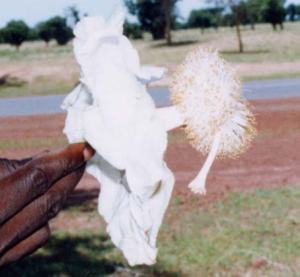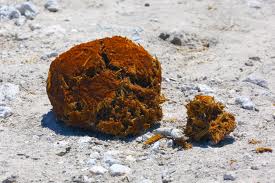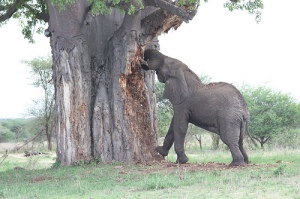Right! Here we are again! I’m never quite sure how to do this; last week, I wrote part 1 of a post about Baobabs. It had a 750 word introduction. And now I’m setting forth on Part 2, which should, I suppose, have absolutely no introduction at all. Which would just seem wrong.
So we’ll just do a quick recap and soldier on. Here goes with the recap; Baobabs are big, but not tall. They are old, but it’s hard to tell how old. And they are succulents. That’s pretty much it, except that it took me nearly 2000 words to say it, which seems, in retrospect, to be a little excessive. Oh well, let’s see if we can grind out another 2000 words.
Being an enormous succulent is not without its risks. You may have noticed that Baobabs look kind of elephantine. Which is a little ironic, because Baobabs have a mortal enemy. One that also looks a little elephantine.
Setting yourself up as an enormous, cool, refreshing sponge full of water in a hot and dry land is bound to tempt the odd creature to have a go at stealing that water. Luckily for the baobab, the only creature that has any realistic chance of doing it any real damage is the elephant. Unluckily for the Baobab, elephants are very good at taking stuff from trees. Since we are a warlike species, we tend to view those sharp white things sticking out of the end of the elephant as weapons. They aren’t. They’re tools that are occasionally used as weapons.
They are used for quite a lot of things, like digging and carrying and pushing, but most of all they’re used for stripping bark from trees. Which, as you will know if you’ve spent some quality time with porcupines or beavers, kills the trees. Most trees. Baobabs, as I might have mentioned, are not most trees.
Baobabs are the only tree I know of that can regenerate their bark. The elephants, desperate for any water they can get towards the end of the dry season, move in and hack away at the trunk of the Baobab, tearing off strips of the bark and leaving the trees in state that would kill most others. But then the rains come, and the Baobabs set about repairing themselves. ‘Til next dry season. You can tell when a Baobab is growing in elephant country because the trunk ends up looking like one of those candles stuck in bottles in cheap Italian restaurants.
This happy little system works just fine. Until you get too many elephants. Then this starts to happen.
Standing in front of a massive, squat, leafless Baobab, you get the impression that it isn’t so much a tree as it is an extension of the earth, like a troll caught by the dawn and twisted into living rock. Baobabs look permanent and solid, like the hills and rocks around them. Which can often be massively deceptive. Many Baobabs aren’t solid at all. They are hollow.
Which makes them pretty useful to the people living around them. As a succulent, the Baobab is designed to survive in some incredibly harsh and waterless places. Human beings, however, are not, but insist on doing so anyway. In desert areas, the human inhabitants would hollow out huge old Baobabs from the top, drill a hole in the trunk, and pop a cork in it, turning the whole damn thing into a water bottle. A giant water bottle. Examples have been found that hold over 4 500 litres, which is pretty handy if you live in a place that gets less than 300ml of rain a year.
But that’s not the only thing you can do with a huge, hollowed out tree. You can live in one, for a start, and people do. But they also turn them into much cooler things than mere houses. Hollow, living Baobabs have been used as prisons, bars, post offices, store-rooms, dairies, and, in keeping with the nobility and gravitas of these imposing giants, a public toilet, complete with running water.
Humans aren’t the only ones who use hollow Baobabs. The wide-open plains of Africa are not rich in caves. At least not ones made of rock. The Baobabs stand in as a pretty decent substitute, and they serve as a home for countless small predators. And bats.
Which is pretty damn handy, because the Baobab needs bats. This is a Baobab flower;
It looks pretty ordinary. Until you see it from the side;
Then it looks a little odd. Those flowers hang upside down, which means that it’s actually not that easy for creatures like birds to reach that tasty ball of pollen at the end there. Bats, however, are quite well known for hanging upside down themselves, so the whole system fits rather neatly together;
Bats are the main pollinators of Baobabs. This is why the flowers are white; they’re easier to see at night. They have a strong, sweet smell for the same reason, which unfortunately turns into a strong, nasty smell once the flowers have fallen. There are other pollinators, like Bushbabies and the occasional bird or insect. Once the flowers have been pollinated, the bush sits back and waits for the fruit to come along. And because we are talking about Baobabs, they are no ordinary fruits.
Fruit exists purely as a bribe. Trees which produce fruit do so in order to get more mobile creatures to spread their seeds, a system that has worked rather well for apples and oranges and the like. Most fruits do this by being sweet and juicy. Not the Baobab.
The main goal of the Baobab, as a succulent, is to save water. Which means that giving away scores of sweet, juicy packages of moisture would be a little counter-productive. So the Baobab doesn’t. Baobab fruit is filled not with juicy pulp, but with a nutritious, tasty, and most of all dry whitish powder. Creatures like monkeys and baboons pick up the hard, woody fruits and carry them around with them for a while, digging out the powdery flesh and, more significantly for the Baobab, scattering the unwanted seeds.
Things are even less complicated when it comes to elephants. The fruit goes in one end, woody skin and all, and the seeds come out the other, complete with their own handy pile of fertiliser. Just in case you think the elephants are making up for their past sins against the Baobab, bear in mind that a juicy little baobab growing in the middle of an elephant path is not going to last very long. To give the Baobab any sort of chance of growing to adulthood, that handy ball of fertiliser is going to have to roll off into a spot that its depositor can’t reach.
But elephants and monkeys aren’t the only creatures eating Baobab fruit. The European Union has just decided that Baobab fruit is safe for consumption by blonde haired ski-instructors named Jorgen. This must have come as a bit of a surprise to the millions of Africans who had cheerfully been eating Baobab fruits for millennia without permission from Brussels. As well as the fruits, they eat the young green leaves. To make up for lost time, the Europeans have decided to call the Baobab a “superfruit”, and use it for making smoothies and energy bars.
The Europeans are not being quite as silly as they sound. The fruit of the Baobab really is pretty damn super. It is rotten with anti-oxidants, has much more vitamin-C than oranges, and much more calcium than spinach.
The Baobab isn’t just good for making smoothies for rapidly oxidising Europeans. The people of Africa use it as medicine. They use it to treat asthma, kidney and bladder diseases and diarrhoea. The usefulness of the Baobab doesn’t stop there. The bark of a number of trees is used to make rope and cloth. Which is nice, but tends to kill the tree. Not the Baobab. With its ability to regrow its bark, it can be used as a source of rope and cloth indefinitely.
Water can be extracted from the roots in an emergency, and out of an emergency water can be mixed with the powder of the fruit to make a tart, refreshing drink reminiscent of lemonade.
Any tree quite as distinctive as the Baobab is bound to attract its share of myths and magic. The most prevalent of these revolve around its appearance. The gist of the story is that the Baobab was a bit of a show-off, boasting about its own magnificence and looking down on all the other trees. To punish the haughty Baobab, the gods ripped it out of the ground and planted it upside down.
These stories make sense if you look at the Baobab; it really does look like it is growing upside down with its roots in the air. What makes a little less sense is the connection between Baobabs and crocodiles. Sucking or eating the seeds of a Baobab will attract crocodiles. Be careful with those smoothies, Jorgen, you demented freak!
This is not, however, the end of the world. Oddly enough, drinking water in which the seeds have been soaked will repel crocodiles. It might take a bit of experimentation, but can you imagine how cool it would be to wash down a Baobab seed or two with a nice, cool glass of Baobab-seed-soaking-water, and then taking a stroll round town with a swarm of crocodiles stuck in a permanent ten metre orbit around you?
The truth is that Baobabs really are magic in a slightly less specific way. Not that I am sniffing at supernatural crocodile management in any way. Nasty buggers. Too many teeth, and that extra eyelid is just creepy. Baobabs are magical in the way all big trees are magical.
And then some. They are the big trees where there are no other trees at all. They are the big trees that we grew up with as a species, sheltering in their hollows, feeding on their bounty, playing in their shade for millions of years before we decided to wander off and invent concrete. They are the big trees that fight off elephants, which are magical themselves.
You should come and see them. You don’t need to hurry; some of them were around when the Romans were conquering the Gauls. They’re sure to be around a little while longer. But pencil it in. Put it on your bucket list. Tolkien and his sort were right. The magic is receding from our world. It’s nearly all gone. But out here, we’ve still got a tiny bit left. We’ve got a tree so big, so wide, so gnarled and twisted and otherworldly that it can hold up the sun as it sets fire to the sky. That is worth seeing. Especially if someone has been kind enough to hand you a gin and tonic.















Reblogged this on Travel Agent Affiliate Program.
I love baobob fruit, my friends and I used to keep a stash of them. Wish I could get them here in California. Guess I’ll have to settle for some roasted pine nuts 🙂
I have, to my shame, never tried them. But I have tried roasted pine nuts. I’ll have to fix that soon.
Indeed, the magic is receding. Thanks for reminding us where a little bit yet resides. And, yes, elephants.
Yup. When the elephants and the baobabs are gone, so is the magic.
Ahhhhh plants. When I drink gin and tonic I often go out and tell my plants I love them HAHAHahaha. Great post!
I have a love-hate relationship with my plants, because the ungrateful bastards die in the frost every winter. But I do profess a vague fondness for them through the window after a G and T or two.
Getting poetic about Baobabs is most definitely allowable.
Thank you again! Yes Baobabs are other-worldy. The first thing I drew as a kid, they have always been special. Thank you!!!
Now I won’t get any work done………dreaming about Baobabs.
Yup. They are pretty easy to dream about, too. If you asked me to draw an oak tree from memory, I would struggle, but the baobab is always right there, fully formed.
An awesome tree, that makes me wish I had been born in Africa 🙂
It has its moments…
Up in Botswana we had a wonderful tree that was on the old “hunters road” on the Zimbabwe border. Travellers had carved their names and dates going back to 1882.
Sadly the elephants ate it..
Yup. You do seem to have rather a lot of the buggers. And we are catching up.
What a tree! I’m surprised they’re not farming them or is that to come?
I wouldn’t imagine so; they can take up to twenty years to flower for the first time. Those big ones in the pictures can be hundreds of years old. Or thousands.
It seems you are the master of ceremonies for the magnificent Baobab – and we thank you for your eloquent and edifying treatise.
Thank you kindly. And I liked it even better when you called it a treatsie. The world needs that word.
It seems you are the master of ceremonies for the magnificent Baobab – and we thank you for your eloquent and edifying treatsie .
I like the poetic bits of your writing best. The information is also very welcome – but the moment when you saw the tree as a part of the earth itself (though, I suppose, at some level trivially true) was wonderful.
Thank you kindly. I shall drink gin and tonic more often.
A massive Gollum rising out of the dust. It’s a wonder Northern Australia isn’t completely overrun by Baobabs. We are significantly devoid of elephantine creatures and the closest thing that we have to a natural predator is a cane toad. Not sure that cane toads naturally gravitate to Baobabs but they are certainly adaptive little buggers so I wouldn’t put it past them…from the front the Baobab’s flower looks a lot like a camellia but from the side it is all hibiscus. Only fitting that something so incredibly chunky and homely (and I am being kind there) should have such awesome flowers. I saw Mr Attenborough explaining the intricacies of dung beetles and their place on the Serengeti. No doubt you have the Lowveld equivalent and I would imagine a deposit of elephantine proportions would be immediately seething in the little adventitious scarabs. Maybe that’s how Baobabs managed to gravitate away from the elephant’s path? Those dung beetles are very tenacious. I have watched one cut a chunk of cow manure and roll it away to a safe distance and then dig its way down into the earth with the precious morsel. I live a most exciting life…please don’t envy me.
Apparently your dung beetles are ours. After Europeans took their livestock over to Australia, they found that the local dung beetles weren’t adapted to deal with foreign poo. The whole continent was in danger of being covered in a thin sheet of sheet; That’s where the world renowned affinity of Australians for flies began.
And then we sorted it all out for you. You see- we do invade you with nice things sometimes.
Much like our endemic worms that are HUGE but incredibly slow at dealing with any bulk mass of forest debris. They are used to working their way through eucalyptus leaves which are apparently very hard to digest so they are huge and fat and slow. We imported red wrigglers to deal with composting and suddenly they are taking over the soil! Sigh…will we EVER learn? Cheers for the dung beetles. They are one of my favourite little creatures. Up to their 6 little armpits in shite and STILL happy as Larry and able to make something out of a pretty disgusting situation. Admirable really 🙂
Lovely. The Baobab is one of my favorite trees. They’re so strange looking. Super capture with the jumbo (elephant) standing beneath.
Not mine, I’m afraid. I live in mortal fear of elephants, and could never distract myself with a camera while they plot my doom.
I’m sorry to hear you’re scared of them. They’re some of my favorite gentle giants. I do, however, have a very big respect and keep my distance from all wildlife. I love to enjoy them in their natural surroundings. Have a good weekend.
Joey
PTSD. Weirdly enough, I’m only scared of them when I’m in a car. On foot, they don’t frighten me at all.
Absolutely fascinating, thank you.
Another winner as always. Great stuff!
Thanks.
I have always thought the Baobab tree was beautiful and otherwordly in its shape and appearance. A tree that does make you think of things magical and tweaks the sense of wonder we all have inside somewhere. However, I never knew these details of its physiology and find it totally fascinating!! A wonderful playful essay filled with amazing information about this strange and evocative tree. Loved it!!
I’m glad you did. Thank you.
“We’ve got a tree so big, so wide, so gnarled and twisted and otherworldly that it can hold up the sun as it sets fire to the sky.”
Getting quite poetic there, aren’t we Mr 23thorns? But you may. They are magnificent.
There’s one next to the road between Upington and Keetmans, just beyond the Namibian border, where my dad always stops for breakfast when they’re headed to the Fish River Canyon. When I went with them a few years ago I just couldn’t help myself but had to have my breakfast up in its branches.
I might have had a gin and tonic or two. Just to get into character. 🙂